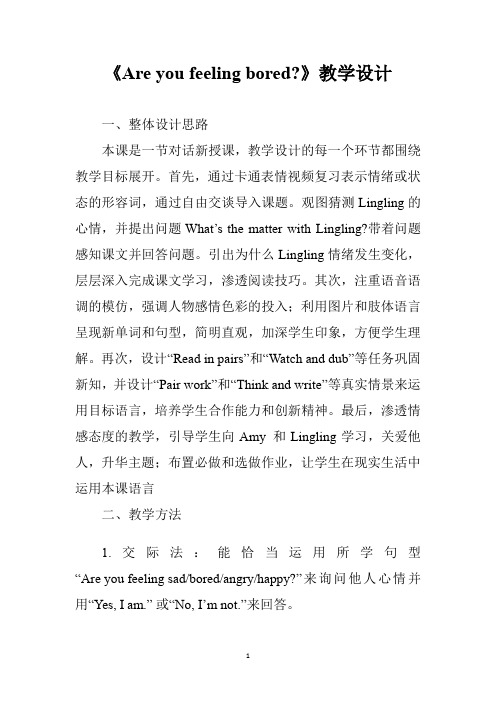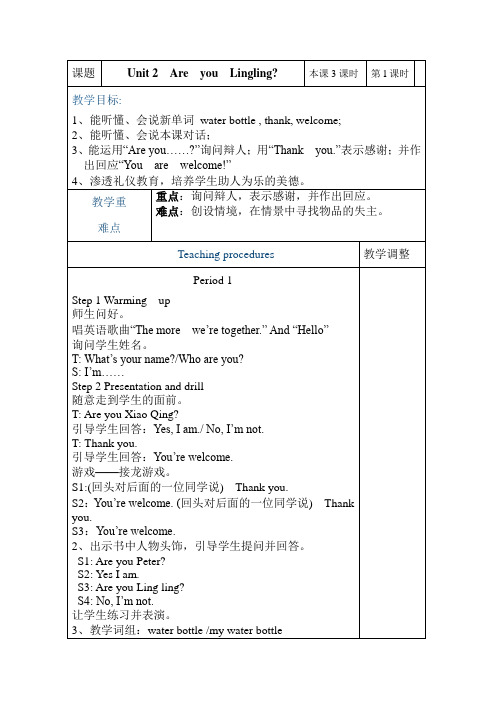Unit2AreyouLingling教学设计
- 格式:pdf
- 大小:82.57 KB
- 文档页数:6

四年级上册英语教案-Module 2 Unit 2 What are you doing 外研版(三起)教学目标•听懂、会说、会读、会写本课时的单词和句型:what are you doing? I’m doing …。
•能听懂短对话听懂大约70%。
•能正确朗读对话内容,并能模仿声音语调,感受语言的韵律。
•能够进行听说训练,正确回答what are you doing? I’m doing …的问题。
•能够描述自己正在做的事情。
教学重难点•重点:Listening and speaking: what are you doing? I’m doing…•难点:能够描述正在进行的事情。
教学步骤Step 1:Revision1.复习上节课所学let’s learn的内容,并进行语音训练。
调整发音和语调。
2.复习上节课所学let’s sing的内容,并进行声音模仿和歌曲演唱。
3.复习上节课所学的句型:I’m playing, I’m reading,呈现出图片让学生们说出正在进行的事情。
Step 2:Presentation1.通过图片和小视频介绍新的句型:what are you doing? I’m doing…2.教师用动作和图片进行配合讲解。
学生注意教师的动作和语言,掌握新的句型。
3.提示学生们认真听、认真观察。
Step 3:Practice1.提问句型:what are you doing?给予图示和动作,让学生进行回答。
教师给予鼓励和提示。
2.两人一组进行问答练习,自然流畅,强调语调和音量。
3.小组合作,进行对话练习,自由发挥,进行互动交流。
Step 4:Production1.让学生自己组织语言,描述自己正在做的事情。
2.让学生进行小组交流,从对方嘴里了解他们正在做的事情。
3.整合上述语言材料,让学生们分角色进行小剧场表演。
Step 5:Evaluation1.教师对学生进行发音、语法和交流能力的总体评估。

《Are you feeling bored?》教学设计一、整体设计思路本课是一节对话新授课,教学设计的每一个环节都围绕教学目标展开。
首先,通过卡通表情视频复习表示情绪或状态的形容词,通过自由交谈导入课题。
观图猜测Lingling的心情,并提出问题What’s the matter with Lingling?带着问题感知课文并回答问题。
引出为什么Lingling情绪发生变化,层层深入完成课文学习,渗透阅读技巧。
其次,注重语音语调的模仿,强调人物感情色彩的投入;利用图片和肢体语言呈现新单词和句型,简明直观,加深学生印象,方便学生理解。
再次,设计“Read in pairs”和“Watch and dub”等任务巩固新知,并设计“Pair work”和“Think and write”等真实情景来运用目标语言,培养学生合作能力和创新精神。
最后,渗透情感态度的教学,引导学生向Amy 和Lingling学习,关爱他人,升华主题;布置必做和选做作业,让学生在现实生活中运用本课语言二、教学方法1.交际法:能恰当运用所学句型“Are you feeling sad/bored/angry/happy?”来询问他人心情并用“Yes, I am.”或“No,I’m not.”来回答。
2.情景教学法:教师引导学生观察Lingling的表情,引入文本情境——Lingling不开心,Amy过来关心她,引导大家一起来猜测Lingling为什么不开心。
3.活动教学法:心理咨询环节和爱心传递卡环节帮助学生学会在现实生活中运用目标语言,学会自己排解和帮助朋友排解不良情绪。
这样就把单调、机械的句型操练变为真实的交际性练习。
让学生在学习新授内容之后,自然地运用到生活中。
三、教学目标分析1.语言知识目标:能听懂、会说句子:“Are you feeling sad/bored/angry/…?”及其答语“Yes, I am.”/“No,I’m not.”能够听、说、认读sad, bored, angry, feel, ill, better等新授单词。

教材分析本课时的课文情景是Amy到Lingling家做客,看到Lingling家墙上挂着一张黑白照片,于是就问Lingling照片上是谁。
Lingling告诉Amy,照片上是自己的爷爷奶奶,他们那时还很年轻。
Lingling又给Amy看爷爷奶奶现在的照片,他们已经很老了。
Amy又问旁边的小女孩是谁,Lingling告诉Amy那是自己2岁时的照片,那时她的头发很短,现在已经长长了。
Amy认为那时的Lingling很可爱,而Lingling回忆说自己那时也很淘气。
在生活中,我们也会遇到类似的情景,谈论老照片,谈论自己或家人的过去与现在的不同,这种情景很贴近生活,利于学生理解掌握。
课时教学目标一、知识目标1. 能听、说、读、写单词:was, were, then, young, old, short, long, hair2. 能用They were young then. I was two then. 谈论过去的状态。
二、能力目标学生能够运用was和were来描述自己或他人过去与现在状态的变化。
三、情感目标通过对比过去和现在的变化,教育学生要学会感恩,感恩父母、亲人、老师和朋友。
教学重点与难点教学重点与难点:1. 能听懂、会说、会读句型:I was…then. They were… then.2. 能够区别运用am, is, are和was, were, 来对比描述自己或他人过去与现在状态的变化。
教学辅助OHP, video, word cards教学策略在教学的过程中采用任务型教学法,采用小组合作学习的方式,以兴趣激发学生,以任务驱动教学。
教学内容(含时间设置)教学活动设计意图教师活动学生活动Step 1: Warm up (about 3 minutes) 唱歌曲:I’m Short And You Are Tall.在节奏感十足的音乐背景的渲染下,既营造了良好的英语学习氛围,又对本课相关的学习内容进行了复习,为下面的学习做好了铺垫。

课题Unit 2 Are you Lingling?本课3课时第1课时教学目标:1、能听懂、会说新单词water bottle , thank, welcome;2、能听懂、会说本课对话;3、能运用“Are you……?”询问辩人;用“Thank you.”表示感谢;并作出回应“You are welcome!”4、渗透礼仪教育,培养学生助人为乐的美德。
教学重难点重点:询问辩人,表示感谢,并作出回应。
难点:创设情境,在情景中寻找物品的失主。
Teaching procedures教学调整Period 1Step 1 Warming up师生问好。
唱英语歌曲“The more we’re together.” And “Hello”询问学生姓名。
T: What’s your name?/Who are you?S: I’m……Step 2 Presentation and drill随意走到学生的面前。
T: Are you Xiao Qing?引导学生回答:Yes, I am./ No, I’m not.T: Thank you.引导学生回答:You’re welcome.游戏——接龙游戏。
S1:(回头对后面的一位同学说) Thank you.S2:You’re welcome. (回头对后面的一位同学说) Thank you.S3:You’re welcome.2、出示书中人物头饰,引导学生提问并回答。
S1: Are you Peter?S2: Yes I am.S3: Are you Ling ling?S4: No, I’m not.让学生练习并表演。
3、教学词组:water bottle /my water bottle学习课文A部分内容。
听课文A部分录音,复述所听内容。
听课文A部分录音,跟读。
Step 3 Practice分组练习课文A部分。
分角色表演。
Step 4 Consolidation创设情境,自由会话。

四年级上册英语教学设计-Module2Unit 2 What are you doing∣外研版(三起)一、教学目标1.学生能够掌握单词:reading、drawing、watching TV、listening、singing 以及句型“-What are you doing? -I’m …”。
2.学生能够在实际生活中灵活运用所学单词和句型进行简单交流。
3.学生能够培养兴趣,主动探究相关语言知识。
4.培养学生的语音、语调、语速等基本语言技能,提升学生的听、说、读、写能力。
二、教学重难点1.词汇:reading、drawing、watching TV、listening、singing。
2.句型:-What are you doing? -I’m …。
3.教学重点:能够理解及运用所学单词和句型进行简单的交流。
4.教学难点:能够准确理解句型并进行语音语调的正确表达。
三、教学准备课本、多媒体教具、幻灯片、图片、录音机等。
四、教学过程1、导入引入相关内容,通过图片和幻灯片进行预习,提高学生对新知识的兴趣和探究欲。
2、新授教师通过教学视频等多种方式将“reading、drawing、watching TV、listening、singing”进行教学,并将这些单词进行分类。
引导学生注意关注发音及语境,加强学生对单词的记忆。
3、操练教师将“reading、drawing、watching TV、listening、singing”的图片分别放在教室四角,要求学生根据老师提问前往指定图片对应的位置。
或随机出示单词,要求学生能够快速进行反应。
4、拓展教师让学生创造句子来描述自己正在做的事情,并鼓励学生互相交流,提升学生对所学知识的应用能力。
5、总结让学生回忆本节课所学的内容,总结出本节课中的重点知识。
五、作业1.自己找一张图片,用英文句子来描述图片中的具体场景。
2.背诵所学单词和句型。
六、教学反思本节课通过多种形式的教学方式进行了新词汇的教学,并对学生进行了多种实践。

外研版初中英语八年级上册全册教学设计教案外研版初中英语八上全册教案及导学案初二英语(上)Module 1 Unit 1 教学设计教材分析:Unit 1通过听、读、说训练,初步学习给别人提建议的方法。
其中活动1要求将所给表示学习活动的词汇分类;活动2要求根据录音判断对话主题;活动3?5听读包含建议的对话并完成填表、答问等任务。
活动6学习英语中的连读法;活动7根据提示口头练习给别人提建议的方法。
教学目标:To get to know the key vocabulary.To understand the dialogue 3.To be able to talk about the problems in learning English.教学重点:Key points: translate, correct, grammar, pronunciation, spelling, try to do,Why don’t you…? How about…教学方法Listening and speaking教具准备Tape recorder教学流程Teacher’s Activity Student’s Activity1.Warming-up 1.Ask the students to introduce themselves first,2.Tell them the importance of learning English and how to learnEnglish3.Say: Now we are going to learn a lot about English, such as grammar ,pronunciation, vocabulary, and how to listen, speak, write and read English. Now please look at activity 1 on page 2Ask students to read the words aloud and try to match them with the headings. It’s best if you cantell them something about each of the item. Make sure students understand each of the items And try to include the words in activity 2 as well!. Take “Grammar” for example:T: Grammar is part of English. It helps us form words and sentences. It helps us check our speaking and writing. For example, you can say “I am Daming.”, but you cannot say “I is Daming.” That’s grammarCheck the answers by asking some students to read the wordsIntroduce themselves first.Listen to the teacher to say about the importance of learning English and how to learn English.Read the words aloud and try to match them with the headings2.In putandpractice Talk about English learningT: English is a widely-used language. People in more than one hundred countries speak English. And many more countries take English as second language. Learning English is fun, and of course not an easy job. But what is in English? What are we going to learn about English? Do you know?Encourage students to speak out what they have in mindS: We’ll learn English letters and wordsS: We’ll learn to speak EnglishS: We’ll learn how to talk to foreigners Speak out What they are going to learn about English?3.Out Put 1. Listening 2First encourage students to tell the meaning of words in activity 2 and try to give some examples for each item, and then ask them to listen to the conversations and match themT: Next we are going to listen to some short conversations. In the conversations, Daming, Lingling and Miss Li are talking about English learning. Listen carefully and try to match these conversations with the words in the box in activity 2. But before this, can you first tell me the meaning of these words?Ask students to tell the meaning of these words either in Chinese or English and then listen to the conversationsCheck the answers. Ask students to try to give the reasons why they choose the words2. Listening and reading 3?5ListeningAsk students to listen to the conversation between Ms James and her students carefully with books closed. Then ask students to listen again and finish activity 4. Check the answers with the class.ReadingAsk students to work in pairs and read the conversation repeatedlyand then ask some pairs to act out the conversation. Then ask and answer the questions in pairsListen to the conversations and match them, tell the meaning of these words either in Chinese or English and then listen to the conversations again.Listen to the tape and finish activity 4.Read the conversation repeatedly and act out the conversation in pairs. Then ask and answer the questions in pairs4. Practice Speaking 6, 7Ask students to listen to and repeat the sentences in activity 6. T: When we speak English, we often read some syllables one ending with consonant and the other beginning with a vowel together. Now listen to the recording and repeat these sentencesAfter a few minutes, ask students to work in pairs and ask and answer the questions in activity 7Sample conversation:S1: What should I do to improve your grammar?S2: You should do more exercisesS1: What else?S2: Try to read more English books and newspapersS1: I’ll try toS2: And don’t forget to read some grammar booksS1: Thanks very much 1.Repeat the sentences in activity2.Work in pairs and ask and answer the questions in activity 7.5. Feedback Give suggestions. Use should, can or I t’s a good idea to…speak English more in classlisten to China Radio Internationalread aloud in the morningwrite new words in groupsread English newspapers Finish the following exercises and have a check.6.Summing-up7.Homework Read the conversation in activity 3 repeatedlyFinish activities 1-4 on page 112 in WorkbookGrade8 Module1 Unit2上课教师学生年级初二教材《英语》(外研社)初二上册课时Module 1 Unit 2教学设计课型Reading and writing教材分析本模块为本学期的第一课,教师要充分利用这一模块的内容,培养学生学习的计划性和策略性,从而有效的指导学生学习。
四年级上册英语教学设计 Module2 Unit2 What are you doing?Activitys 1-3 外研版(三起)一、教学目标1.能听、说、认读单词:reading,writing,singing,dancing等;2.能听懂并回答简单的英语询问句“What are you doing?”;3.能自己编写询问句“What are you doing?”及回答句“I amreading/writing/singing/dancing”;4.培养学生的语言表达能力,增强英语学习兴趣。
二、教学重难点1.教学重点:听、说、认读四个动词,询问答句的学习和掌握;2.教学难点:区分四个动词的发音和意思。
三、教学过程1. Warming up在教学开始前,通过唱歌或跳舞等方式让学生放松身心、进入英语学习状态。
2. Presentation教师通过展示图片或现场演示等方式,向学生介绍“reading,writing,singing,dancing”这四个单词,并让学生重复跟读、模仿发音。
3. Practice 1教师出示四个单词的图片,询问学生“What are you doing?”,让学生用英语回答。
4. Practice 2教师出示四个单词的图片,让学生问同桌“What are you doing?”,询问完毕后,让同桌回答。
5. Practice 3让部分学生来到教室前,站在教室中央表演自己正在做的事情,并问同桌“What are you doing?”,同桌回答“I amreading/writing/singing/dancing”。
6. Extension教师出示其他动词的图片,让学生尝试用英语询问并回答。
7. Homework让学生自己编写询问句“What are you doing?”及回答句“I amreading/writing/singing/dancing”,并在下一堂课向同学表演。
Module 6教学设计Unit 2 What does Lingling have at school?教学目标:1、认识、会读新单词:class, music, Chinese, maths, art, PE, science2、能够用句What does she/he have at school?以及What does she/he do at the weekend?询问别人的学校生活情况以及周末活动安排,并能够替别人回答其描述。
3、能够谈论不在场人的学校生活情况以及周末活动安排。
教学重点:能够用句What does she/he have at school?以及What does she/he do at the weekend?教学难点:询问别人的学校生活情况以及周末活动安排,并能够替别人回答其描述。
教学准备:多媒体、图片、单词卡教学过程:Step 1: Warm up1. Greetings.(师生激情打招呼)2. 复习Module 6 Unit1的重点句型:What do you have at school?I have …Step 2: Presentation1. T: Today two friends will come to our class, let’s see who are they?(出示Daming and Lingling)2. 教师询问学生What do you have at school,today?S: I have…教授新单词today教师领读,学生跟读,小组读,个别读给读得好的学生加分鼓励。
3. 教师出示Daming and Lingling的课程表,并问:What does she/he have at school, today?引导学生回答She/he has…(此环节引出新单词Music, Art, PE并进行全班练习。
)4. 学习课文第一部分第一幅的内容,通过Listen and answer,让学生熟悉课文的内容及更好的掌握句子What does she have at school, today?Step 3: Teacher-student interaction1. T: Tomorrow is Saturday, I sleep at the weekend, Let’s see what does Daming do at the weekend?教师导出Daming的周末活动,同时出示play football, go swimming, watch TV, sleep图片,让学生猜What does Daming do at the weekend? 并引导学生回答He…2.放第一遍录音,学生带着以下问题听What does Lingling do have at school?3. 再次播放录音,学生跟读课文后在小组内分角色朗读课文,小组展示。
《英语》(新标准)(小学一起)三年级下册M2教学设计
生:听录音,跟读模仿课文。
然后和同位练习对话。
Ss can use “will”to 幻灯片出示上节课学习的伦敦的分钟)(一)师:三、训练巩固(12describe the 三处景点,请学生用上节课学的句子描述这些
pictures. 景点。
生:用上节课学的句子描述这些景点。
P8 Activity 1(二)课堂活动用书
师:请学生听录音,画上你听到的东西。
可以参考活动二的图片。
然后用视讯展台来展示部分孩子的图画。
(三)师:播放录音,教授歌曲:The London
Eye
首先,请学生听一遍歌曲,找出描述伦敦眼的Consolidate the key 单词。
然后请学生一句一句的学唱歌曲。
最后sentences by doing 请学生跟随音乐演唱歌曲。
the exercises. 生:听录音,找单词,并学唱歌曲。
四、课堂小结(5分钟)学生试着总结今天课堂学习内容,试着描述伦Help the students to summarize by 敦的三处景点themselves.
课堂评价根据幻灯片提示复述课文。
课题Unit 2 Are you Lingling?本课3课时第1课时教学目标:
1、能听懂、会说新单词water bottle , thank, welcome;
2、能听懂、会说本课对话;
3、能运用“Are you……?”
询问辩人;用“Thank you.”表示感谢;并作出回应“You are welcome!”
4、渗透礼仪教育,培养学生助人为乐的美德。
教学重难点重点:询问辩人,表示感谢,并作出回应。
难点:创设情境,在情景中寻找物品的失主。
Teaching procedures教学调整Period 1
Step 1 Warming up
师生问好。
唱英语歌曲“The more we’re together.” And “Hello”询问学生姓名。
T: What’s your name?/Who are you?
S: I’m……
Step 2 Presentation and drill
随意走到学生的面前。
T: Are you Xiao Qing?
引导学生回答:Yes, I am./ No, I’m not.
T: Thank you.
引导学生回答:You’re welcome.
游戏——接龙游戏。
S1:(回头对后面的一位同学说) Thank you.
S2:You’re welcome. (回头对后面的一位同学说) Thank you.
S3:You’re welcome.
2、出示书中人物头饰,引导学生提问并回答。
S1: Are you Peter?
S2: Yes I am.
S3: Are you Ling ling?
S4: No, I’m not.
让学生练习并表演。
3、教学词组:water bottle /my water bottle
学习课文A部分内容。
听课文A部分录音,复述所听内容。
听课文A部分录音,跟读。
Step 3 Practice
分组练习课文A部分。
分角色表演。
Step 4 Consolidation
创设情境,自由会话。
评价。
对学生的表演进行评价,给予肯定与鼓励,激发学生说英语的欲望。
练习。
板书设计:教学后记:
课题Unit 2 Are you Lingling?本课3课时第2课时教学目标:
1、能听懂、会说新单词 a boy , a girl ,a man, a woman, a doll.
2、能区分boy , girl , man, woman的含义。
3、能唱本课歌曲;
4、通过唱唱、跳跳、玩玩,增强学生学习的兴趣。
教学重、难
点重点:新单词;歌曲Are you Ling ling?
难点:理解“Where are you?” A nd “so glad to see you again”
Teaching procedures教学调整
Step 1 Warming up
师生问候。
唱已学过的英语歌曲。
3、创设情境,复习已学过的句型.
Are you……?
Yes, I am./ No, I’m
not.
自由会话并表演。
Step 2 Presentation and drill
出示一个男孩的头饰或单词卡片 a boy,板书,并带读。
然后让班上的男同学逐个练说I’m a boy.
用同样的方法教单词 a girl ,a man, a woman, a doll.
听课文B部分录音,学生跟读。
游戏——快速反应
在讲台上摆放Anne, Peter ,Miss Li, Mr. Lin等人物图片。
将全班分为男、女两组,各组派一名代表上台比赛。
当教师在他们身后举起
一张单词卡片,如 a girl,全班同学大声说 a girl,两名代表快速地举起相应的图片,速度快的为胜。
Step 3 Practice
游戏——猜一猜。
请一名学生上台,从台上的人物(Anne, Peter ,Miss Li, Mr. Lin 等)图片中选出想扮演的角色,却不让其他人知晓,请全体同学和
老师猜一猜。
T: Are you a boy?
S1: No, I’m not.
S2: Are you a man?
S1: Yes I am.
S3: Are you Mr. Lin?
S1: Yes I am.
……
课文C部分。
(1)、表扬学生刚才的游戏玩得好,奖励他们欣赏歌曲。
听录音,。